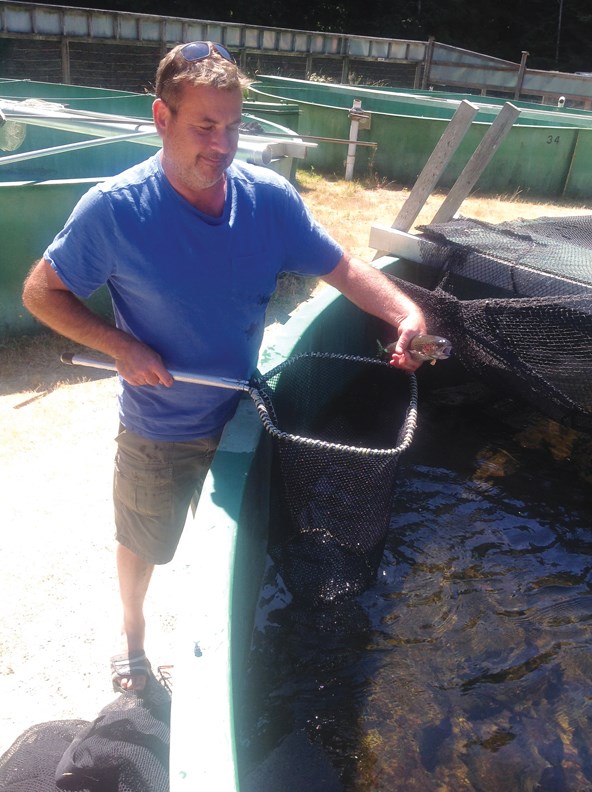The manager of the Chapman Creek Hatchery says low water flows and increasing temperatures could put its fish at risk, and he’s hoping the Sunshine Coast Regional District (SCRD) and the province will work with the hatchery to allow a higher minimum flow rate.
The hatchery, which is run by the Sunshine Coast Salmonid Enhancement Society, has advocated for the SCRD to release more water into the creek several times before, and manager David Burnett has long argued that the minimum set under the SCRD’s water licence is too low.
The topic was the subject of two meetings this spring, on May 12 and June 16, between officials from the hatchery and its community partners, the SCRD, and representatives of the Ministry of Forests, Lands and Natural Resource Operations (FLNRO).
The meetings were informal and closed to the public, but in her report to the SCRD board June 22, CAO Janette Loveys said, “The focus continues to be on understanding the Water Sustainability Act and the respective roles/responsibilities and communication.”
The Sunshine Coast Salmonid Enhancement Society’s licence to divert water from Chapman Creek is considered junior to the SCRD’s licence, which is part of the regional drinking water system. The SCRD needs to ensure an adequate supply over the summer, but under the Water Sustainability Act (WSA), FLNRO can issue an order to release enough water to allow a flow of 200 litres/second when the natural flow in Chapman Creek is too low.
FLNRO issued that order on July 19, and in a letter to the Society, informing it of the order, it said that because the SCRD licence has seniority, the hatchery is not authorized to divert water if the flow at the SCRD diversion is at, or below, the 200 litres/second minimum. The letter goes on to say that if the Society diverts water and causes the flow rate to drop below minimum at its intake, it would be in violation the Act and liable to penalties.
“If they [SCRD] set it at that [200 litres/second] rate, effectively we are not allowed to take any water out of Chapman Creek,” Burnett said. “FLNRO and the SCRD know we can’t take water at that flow level.”
According to Burnett, the hatchery is using only about one quarter of the flow allowed under its licence.
SCRD officials told Coast Reporter that as of Monday the actual flow was in the 225 litres/second range, after being supplemented by the release of water by the SCRD.
That means for now the hatchery can take water without violating the WSA, but Burnett said he’s worried the SCRD will drop the flow right to the minimum if the hot, dry weather continues.
The Chapman Creek Hatchery faced a similar situation during the 2015 drought and turned to a well on its property as an emergency water source. This summer, however, FLNRO has told Burnett the well cannot be used unless the Salmonid Enhancement Society gets a water licence for non-domestic use.
Burnett said the need for hydrology assessments to support the application would put a strain on their limited resources, and he asked FLNRO to allow the hatchery to use the well until it’s able to submit the application. He said he believes that’s justified because of its past use of the well. The WSA, which came into force in 2016, gives people currently using groundwater for non-domestic purposes until March 1, 2019 to apply for a licence.
Burnett also claims an alternative suggested by FLNRO – pumping the water from the point it flows out of the hatchery back up to the intake on the creek – is unworkable.
Burnett paints a grim picture of what might happen without a strategy to ensure a flow rate that allows the hatchery to continue taking water.
He claims without an assured water source, the hatchery would be forced to release 50,000 coho fry into Chapman Creek, and about 30,000 more into Halfmoon Bay, 10 months early. He said those fry would face a harsh environment and they’d likely not survive.
“When the flow lowers, the temperatures go up. This week the ambient [air] temperature is going to be 28 to 30 [degrees]. The temperatures in the creek are going to go over 20 Celsius at the bottom.”
“The run will stop,” Burnett said. “It will impact us for four years time [after that].”
Burnett said the hatchery would also have to cull several thousand of the rainbow trout it raises for sale as food and as part of its education and recreation programs. He estimates the financial hit could be as much as $10,000.
And after the first pink salmon was spotted this week, Burnett is concerned about keeping water flowing through the hatchery’s outlet pipe so returning fish will swim into the trap.
“The main concern is the impact on the brood stock. If we don’t have water flowing out, we can’t get fish in.”
The SCRD said this week that it’s “very proud of the environmental benefits our management of summer stream flow provides” and pointed out that changes to the minimum flow set out in its licence are at the discretion of the province.
The statement also pointed out that discretion includes the ability to instruct the SCRD to increase the flow during high tide when spawning salmon are being stranded in lower Chapman Creek to allow them to get upstream.
Burnett said he’s been in contact with SCRD and FLNRO officials as well as the shíshálh Nation, but there hasn’t been a meeting since the one on June 16.
Powell River-Sunshine Coast MLA Nicholas Simons said he’s brought the situation to the attention of the new minister, Doug Donaldson.
“We have a community program that’s well liked and that’s facing a challenge,” he said. “And that challenge is one that merits a closer look.”
FLNRO did not respond to Coast Reporter’s request for comment.
For more information on conditions at the hatchery, see scsalmon.org



